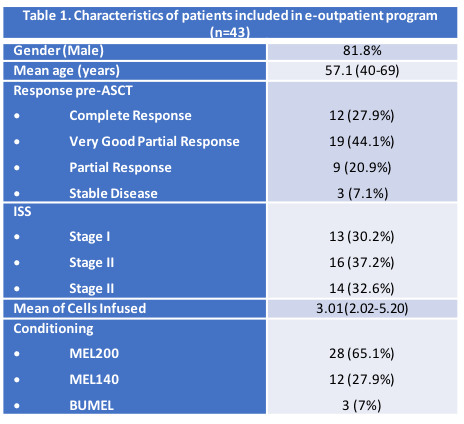
Contributions
Abstract: EP1250
Type: E-Poster Presentation
Session title: Stem cell transplantation - Clinical
Background
Autologous Hematopoietic Stem Cell Transplantation (ASCT) is a therapeutic procedure used as consolidation therapy in different acute hemopathies, especially Multiple Myeloma (MM) and Lymphomas.
There are centers with experience in home care programs that avoid hospital admission partially (aplasia phase) or total (conditioning and infussion day include). This model of attencion requires the support of visits from health personnel, mainly home nursing.
In our center we have designed a mixed care model based on telemedicine and visits to an outpatient clinic twice a week, named e-outpatient. For monitoring during the stay at home we have developed a mobile app (THAD® app) with different utilities (registry of constants, treatment adherence, videoconference) that allows us to control the patient's condition twentyfour hours/seven days.
Aims
Our main objective is to describe the efficacy and safety of this type of care in MM patients undergoing ASCT included in the e-outpatient program.
Methods
A one center retrospective study, with data obtained from the electronic clinical history, in our center from 2015 to 2020. Statistical analysis has been performed with IBM SPSS.19.
Results
During the study period, 112 patients with a diagnosis of MM underwent ASCT, 43 of them (38.4%) were included in the e-outpatient program. The characteristics of the patients are listed in Table 1.
The median days of hospital admission for the included patients was 5 (0-25). The median neutrophil and platelet engraftment was 13 and 15 days. Median red blood cell and platelet concentrates were 0 and 2 respectively. None of the patients required parenteral nutrition during the procedure. The hospital readmission rate was 27.9%. The causes of readmission were mainly fever (58.3%) and Grade III-IV gastrointestinal toxicity (41.7%).
The incidence of febrile syndrome in our series was 65.1% (28/43). The median number of empirical antibiotics used was 0 (0-3). The infectious syndromes reported were febrile neutropenia without focus (25 episodes), pulmonary aspergillosis (1 episode), Escherichia Coli bacteremia (1 episode) and soft tissue infection (1 episode). No deaths have been registered.

Conclusion
1. The use of telemedicine in home care programs is an opportunity to reduce the need for health support resources at home.
2. Our e-outpatient program shows a significant reduction in the days of admission (median 5) compared to conventional hospitalization (3 weeks), allowing less exposure to nosocomial germs, a lower cost associated with admission and a better emotional adaptation to the process of the patient and their caregiver.
3. The safety profile is adequate, with an acceptable incidence of infectious complications, with a transplant-related mortality of 0%.
4. Readmission rate (28.9%) is relatively high compared to similar outpatient programs. The combination of technological tools with home care can be a good option to reduce hospital readmissions.
Keyword(s): Autologous hematopoietic stem cell transplantation, Multiple myeloma, Quality of life
Abstract: EP1250
Type: E-Poster Presentation
Session title: Stem cell transplantation - Clinical
Background
Autologous Hematopoietic Stem Cell Transplantation (ASCT) is a therapeutic procedure used as consolidation therapy in different acute hemopathies, especially Multiple Myeloma (MM) and Lymphomas.
There are centers with experience in home care programs that avoid hospital admission partially (aplasia phase) or total (conditioning and infussion day include). This model of attencion requires the support of visits from health personnel, mainly home nursing.
In our center we have designed a mixed care model based on telemedicine and visits to an outpatient clinic twice a week, named e-outpatient. For monitoring during the stay at home we have developed a mobile app (THAD® app) with different utilities (registry of constants, treatment adherence, videoconference) that allows us to control the patient's condition twentyfour hours/seven days.
Aims
Our main objective is to describe the efficacy and safety of this type of care in MM patients undergoing ASCT included in the e-outpatient program.
Methods
A one center retrospective study, with data obtained from the electronic clinical history, in our center from 2015 to 2020. Statistical analysis has been performed with IBM SPSS.19.
Results
During the study period, 112 patients with a diagnosis of MM underwent ASCT, 43 of them (38.4%) were included in the e-outpatient program. The characteristics of the patients are listed in Table 1.
The median days of hospital admission for the included patients was 5 (0-25). The median neutrophil and platelet engraftment was 13 and 15 days. Median red blood cell and platelet concentrates were 0 and 2 respectively. None of the patients required parenteral nutrition during the procedure. The hospital readmission rate was 27.9%. The causes of readmission were mainly fever (58.3%) and Grade III-IV gastrointestinal toxicity (41.7%).
The incidence of febrile syndrome in our series was 65.1% (28/43). The median number of empirical antibiotics used was 0 (0-3). The infectious syndromes reported were febrile neutropenia without focus (25 episodes), pulmonary aspergillosis (1 episode), Escherichia Coli bacteremia (1 episode) and soft tissue infection (1 episode). No deaths have been registered.

Conclusion
1. The use of telemedicine in home care programs is an opportunity to reduce the need for health support resources at home.
2. Our e-outpatient program shows a significant reduction in the days of admission (median 5) compared to conventional hospitalization (3 weeks), allowing less exposure to nosocomial germs, a lower cost associated with admission and a better emotional adaptation to the process of the patient and their caregiver.
3. The safety profile is adequate, with an acceptable incidence of infectious complications, with a transplant-related mortality of 0%.
4. Readmission rate (28.9%) is relatively high compared to similar outpatient programs. The combination of technological tools with home care can be a good option to reduce hospital readmissions.
Keyword(s): Autologous hematopoietic stem cell transplantation, Multiple myeloma, Quality of life


